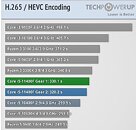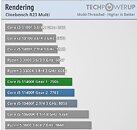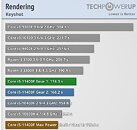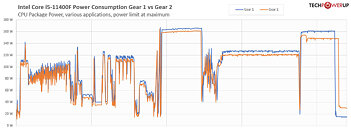- Joined
- Oct 9, 2007
- Messages
- 47,214 (7.55/day)
- Location
- Hyderabad, India
| System Name | RBMK-1000 |
|---|---|
| Processor | AMD Ryzen 7 5700G |
| Motherboard | ASUS ROG Strix B450-E Gaming |
| Cooling | DeepCool Gammax L240 V2 |
| Memory | 2x 8GB G.Skill Sniper X |
| Video Card(s) | Palit GeForce RTX 2080 SUPER GameRock |
| Storage | Western Digital Black NVMe 512GB |
| Display(s) | BenQ 1440p 60 Hz 27-inch |
| Case | Corsair Carbide 100R |
| Audio Device(s) | ASUS SupremeFX S1220A |
| Power Supply | Cooler Master MWE Gold 650W |
| Mouse | ASUS ROG Strix Impact |
| Keyboard | Gamdias Hermes E2 |
| Software | Windows 11 Pro |
In the course of our Core i5-11400F "Rocket Lake" processor review, we discovered that the Gear 2 memory mode has the potential to offer higher performance than Gear 1. The Gear 1 mode runs the memory frequency and memory controller frequency in 1:1 sync, while the Gear 2 mode runs them at 1:2, meaning that the memory controllers run at half the memory frequency, allowing you additional memory overclocking headroom. At lower, more stable, memory frequencies, it should be logical to use Gear 1. Our testing springs some surprising results.
Overall, a stock Core i5-11400F paired with DDR4-3733 MHz memory, was found to be 1.5% faster with Gear 2, when averaged across all our CPU tests, compared to Gear 1 at the same 3733 MHz frequency. Gear 2 was 3.42% faster in Cinebench R23 multi-threaded, and a staggering 6% in MySQL. Across rendering and media workloads that scale across all cores, we find Gear 2 faster by 1-3%. It's only with less parallelized workloads such as gaming, where we see Gear 2 lag behind Gear 1, though not by much. In our i5-11400F review, we show that by running your processor in Gear 2, you're making your memory controllers pull less power, freeing up power budget for the CPU cores, translating into the nT performance gains we see here. We discovered that the uncore can pull anywhere between 5 to 10 W more power in Gear 1 mode. This is valuable power eating into the already constrained power-budget of this 65 W TDP chip.
Read the Intel Core i5-11400F TechPowerUp Review




This behavior wasn't spotted in our launch-day i5-11600K and i9-11900K reviews; as the i5-11400F is our first Rocket Lake with a 65 W TDP. We expect the disparity between Gear 2 and Gear 1 at stock settings to only grow wider with higher core-count 65 W models, such as the Core i7-10700/F and the i9-11900/F. Gear 1 claws its way back to the top when you engage power limit overrides offered by motherboards. These overrides vary from motherboard to motherboard, but they generally free up more power budget for your CPU cores to sustain their boost frequencies better. For more data and commentary, be sure to catch our Core i5-11400F review.
View at TechPowerUp Main Site
Overall, a stock Core i5-11400F paired with DDR4-3733 MHz memory, was found to be 1.5% faster with Gear 2, when averaged across all our CPU tests, compared to Gear 1 at the same 3733 MHz frequency. Gear 2 was 3.42% faster in Cinebench R23 multi-threaded, and a staggering 6% in MySQL. Across rendering and media workloads that scale across all cores, we find Gear 2 faster by 1-3%. It's only with less parallelized workloads such as gaming, where we see Gear 2 lag behind Gear 1, though not by much. In our i5-11400F review, we show that by running your processor in Gear 2, you're making your memory controllers pull less power, freeing up power budget for the CPU cores, translating into the nT performance gains we see here. We discovered that the uncore can pull anywhere between 5 to 10 W more power in Gear 1 mode. This is valuable power eating into the already constrained power-budget of this 65 W TDP chip.
Read the Intel Core i5-11400F TechPowerUp Review




This behavior wasn't spotted in our launch-day i5-11600K and i9-11900K reviews; as the i5-11400F is our first Rocket Lake with a 65 W TDP. We expect the disparity between Gear 2 and Gear 1 at stock settings to only grow wider with higher core-count 65 W models, such as the Core i7-10700/F and the i9-11900/F. Gear 1 claws its way back to the top when you engage power limit overrides offered by motherboards. These overrides vary from motherboard to motherboard, but they generally free up more power budget for your CPU cores to sustain their boost frequencies better. For more data and commentary, be sure to catch our Core i5-11400F review.
View at TechPowerUp Main Site




